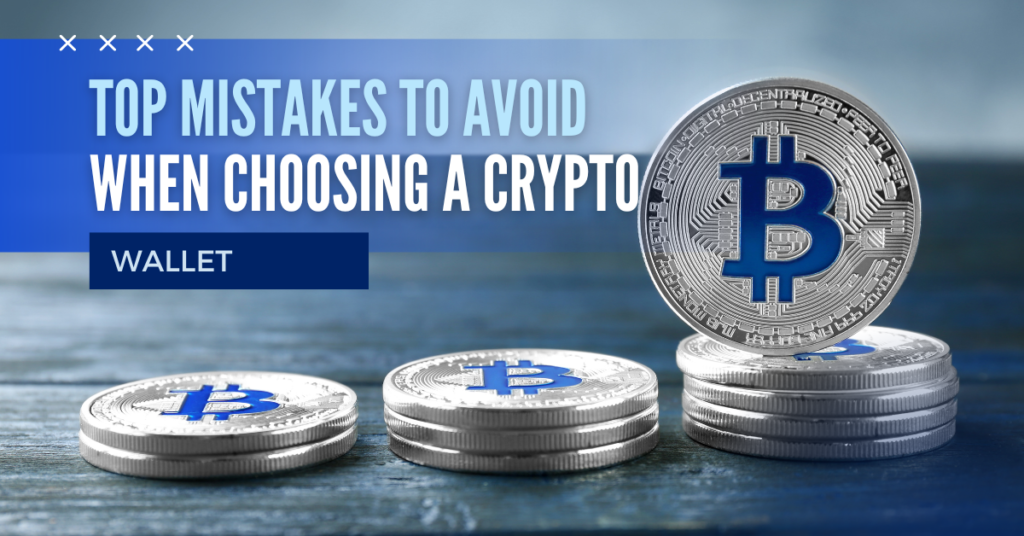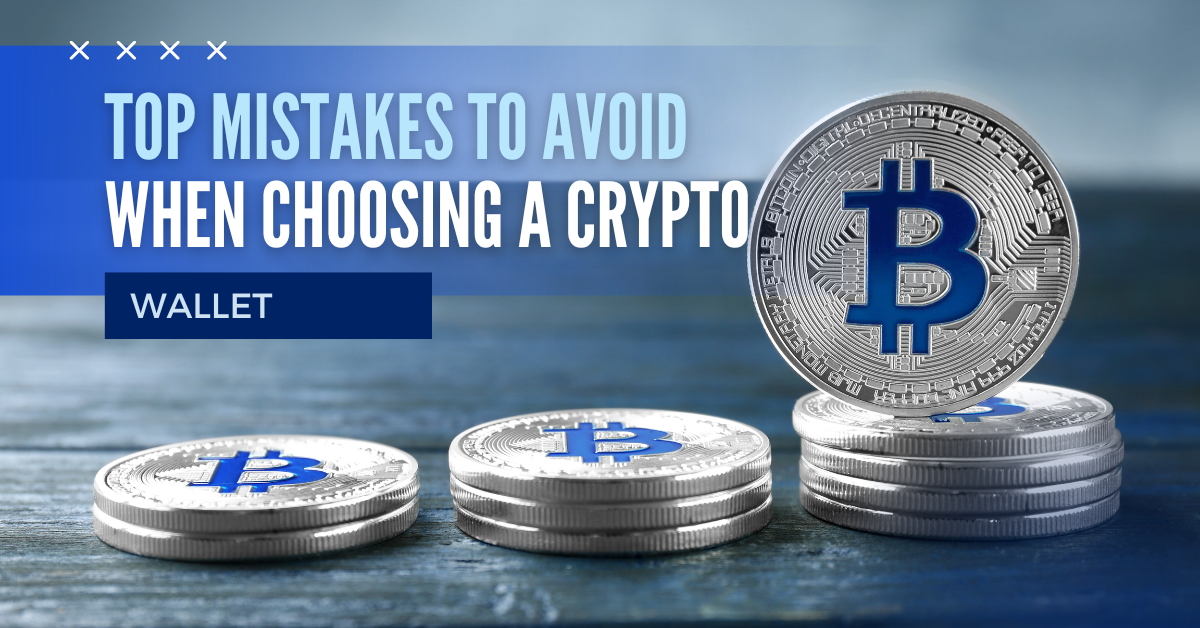Cryptocurrency is a rapidly evolving space that offers tremendous potential for financial freedom. With the rise of digital assets, the need for secure storage has become more critical than ever. One of the fundamental steps in safeguarding your crypto investments is choosing a crypto wallet that meets your needs and protects your funds. However, with numerous wallet types and features available, it’s easy to make mistakes that could lead to the loss or compromise of your digital assets. In this article, we’ll explore the top mistakes to avoid when choosing a crypto wallet and provide best practices to help you make an informed decision.

1. Failing to Understand the Different Types of Crypto Wallets
One of the most common mistakes when choosing a crypto wallet is failing to recognize the different types of wallets and their respective functionalities. Crypto wallets generally fall into two categories: hot wallets and cold wallets.
- Hot Wallets: These are connected to the internet and include mobile, desktop, and web-based wallets. They are easy to access but are more vulnerable to hacks.
- Cold Wallets: These wallets are offline, such as hardware wallets or paper wallets. They provide a higher level of security but are less convenient for frequent transactions.
Mistake: Many users, especially beginners, choose a wallet based solely on convenience without considering the trade-offs between security and accessibility when choosing a crypto wallet.
Best Practice: If you are holding a significant amount of cryptocurrency, consider using a combination of both hot and cold wallets. For daily transactions, use a hot wallet, and for long-term storage, opt for a cold wallet. Understanding these wallet types is essential when choosing a crypto wallet that fits your needs.
2. Overlooking Wallet Security Features
Security is paramount when it comes to cryptocurrency wallets. One of the most significant mistakes users make when choosing a crypto wallet is overlooking crucial security features, assuming all wallets offer the same protection.
Mistake: Some users choose wallets that lack advanced security features like two-factor authentication (2FA), multi-signature options, or hardware integration.
Best Practice: Always prioritize security when choosing a crypto wallet. Look for wallets that offer:
- Two-Factor Authentication (2FA): Adds an extra layer of security by requiring a second form of verification.
- Multi-Signature Wallets: These require multiple private keys to authorize a transaction, making it harder for hackers to steal funds.
- Seed Phrase Backup: Ensure the wallet provides a recovery seed phrase that can be used to restore your wallet if it’s lost or compromised.
3. Not Researching the Wallet Provider
Not all wallet providers are created equal. A critical mistake to avoid when choosing a crypto wallet is failing to research the background and reputation of the wallet provider.
Mistake: Some users download wallets from unknown or unreliable sources, leading to the risk of scams, malware, or phishing attacks.
Best Practice: When choosing a crypto wallet, opt for one from reputable and well-established providers. Always download wallets from official websites or app stores to avoid counterfeit versions. Research the company, read user reviews, and check for any past security breaches to ensure you are making the right decision.
4. Ignoring Backup Options
Even the most secure wallets can fail, and not having a backup plan when choosing a crypto wallet can lead to the permanent loss of your funds.
Mistake: Some users fail to back up their wallet or store their recovery seed phrase in a secure location. Without a backup, if you lose access to your wallet (due to device loss, corruption, or theft), there’s no way to recover your funds.
Best Practice: Always back up your wallet, especially your recovery seed phrase or private keys. When choosing a crypto wallet, ensure that it offers a reliable and easy-to-use backup system. Store the backup in multiple secure, offline locations like a safe or vault.
5. Storing Large Amounts in Hot Wallets
While hot wallets are convenient for frequent transactions, storing large sums of cryptocurrency in them is a significant security risk. This is an important consideration when choosing a crypto wallet.
Mistake: Users sometimes leave large balances in hot wallets without considering the higher risk of hacks and security breaches. Hot wallets are more susceptible to cyberattacks because they are connected to the internet.
Best Practice: For large amounts of cryptocurrency, use a cold wallet (hardware wallet or paper wallet) that is offline and therefore much less vulnerable to hacks. Only keep what you need for everyday transactions in a hot wallet. Always think about security when choosing a crypto wallet for storing large funds.
6. Using Custodial Wallets Without Understanding the Risks
Custodial wallets are wallets where a third party, usually an exchange or platform, holds the private keys on your behalf. While they can be convenient, they come with risks that should be carefully considered when choosing a crypto wallet.
Mistake: Some users opt for custodial wallets without fully understanding that they do not control their private keys. This means that if the platform is hacked or goes bankrupt, you could lose access to your funds.
Best Practice: Remember the saying, “Not your keys, not your crypto.” Always prefer non-custodial wallets where you have full control over your private keys. If you must use a custodial wallet (e.g., for trading), limit the amount stored and move the majority of your funds to a non-custodial wallet after choosing a crypto wallet that offers both security and flexibility.
7. Neglecting Compatibility with Cryptocurrencies
Not all wallets support every cryptocurrency. A common mistake when choosing a crypto wallet is selecting a wallet without confirming whether it supports the specific coins or tokens you want to store.
Mistake: Some users select a wallet based on general popularity without checking if it is compatible with their specific cryptocurrencies. This can result in frustration and even the loss of funds if incompatible coins are sent to the wallet.
Best Practice: Always check the list of supported cryptocurrencies before choosing a crypto wallet. If you hold multiple types of digital assets, look for a multi-currency wallet that supports all or most of your holdings.
8. Falling for Wallet Scams and Phishing Attacks
As the crypto industry grows, so do the scams targeting crypto users. Phishing attacks and fake wallets are prevalent, and unsuspecting users can easily fall victim if they are not cautious when choosing a crypto wallet.
Mistake: Some users download fake wallets or click on phishing links that mimic legitimate wallet providers, leading to the theft of their private keys and funds.
Best Practice: Always verify the authenticity of the wallet provider’s website or app before downloading. Never click on links from unsolicited emails or messages claiming to be from wallet providers. Enable 2FA for additional protection, and regularly update your wallet software to the latest version after choosing a crypto wallet to patch any security vulnerabilities.
9. Choosing a Wallet Without Customer Support
In the event that something goes wrong, having reliable customer support can make a huge difference. Unfortunately, many users overlook this aspect when choosing a crypto wallet.
Mistake: Some users choose wallets without considering whether the provider offers customer support. If an issue arises, such as losing access to the wallet or encountering a technical glitch, lack of support can be frustrating.
Best Practice: When choosing a crypto wallet, select a provider that offers comprehensive customer support. Check if they provide email, live chat, or phone support, and ensure they have a good reputation for responsiveness.
10. Not Understanding Wallet Fees
Each wallet has its own fee structure, which can vary depending on the type of transactions you are making (e.g., sending, receiving, or trading cryptocurrencies). Understanding this is vital when choosing a crypto wallet.
Mistake: Users may choose a wallet without understanding the fee structure, leading to unexpected costs, especially for frequent transactions.
Best Practice: Research the fee structure of the wallet you’re considering. Understand the transaction fees, withdrawal fees, and any other costs associated with using the wallet. If you plan to trade or send crypto frequently, opt for wallets with lower transaction fees or ones that offer customizable fee options when choosing a crypto wallet.
11. Not Considering Mobile vs. Desktop Wallets
The platform on which your wallet operates is another important factor to consider. Some wallets are mobile-only, while others are available as desktop versions. This distinction matters when choosing a crypto wallet that suits your lifestyle.
Mistake: Some users choose a wallet without thinking about how and where they’ll be using it. For example, if you prefer using a desktop computer but select a mobile-only wallet, this could lead to inconvenience or less frequent use.
Best Practice: Consider your own usage habits before choosing a crypto wallet. If you prefer managing your crypto on the go, a mobile wallet may be the best option. If you manage your crypto from home, a desktop wallet might be more suitable.
12. Assuming All Hardware Wallets Are Equally Secure
Hardware wallets are often considered the gold standard for security. However, not all hardware wallets offer the same level of security and ease of use. This can lead to mistakes when choosing a crypto wallet for long-term storage.
Mistake: Users sometimes assume that just because a wallet is a hardware wallet, it automatically provides maximum security. In reality, there are differences in security features, ease of use, and cost among various brands.
Best Practice: Research different hardware wallet brands before choosing a crypto wallet. Look for well-reviewed options that offer features like PIN protection, passphrase support, and tamper-proof seals. Popular options include Ledger and Trezor, which are widely regarded for their security features.
13. Failing to Plan for Crypto Inheritance
While it might not be pleasant to think about, planning for the inheritance of your cryptocurrency is essential when choosing a crypto wallet.
Mistake: Some users fail to make a plan for how their crypto assets will be accessed if they pass away, leaving loved ones without access to their funds.
Best Practice: When choosing a crypto wallet, consider creating a plan for inheritance. This might involve securely storing your recovery seed phrase and sharing it with a trusted individual or using a crypto inheritance service designed to manage crypto assets in the event of your death.
Conclusion
When choosing a crypto wallet, avoiding these common mistakes can significantly enhance the security and usability of your cryptocurrency holdings. Always prioritize research, security features, and compatibility with your specific needs. Stay informed about evolving risks and technologies, and most importantly, take control of your private keys to safeguard your digital assets.
By following these guidelines, you’ll be well-equipped to make the best decision when choosing a crypto wallet, ensuring your funds are safe, accessible, and secure for both short-term transactions and long-term storage.



Thanks
Hello 🤗
Thanks
Thanks par
Thanks 💕
Thanks
Thanks par